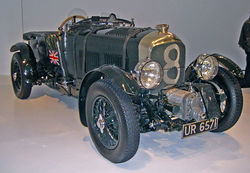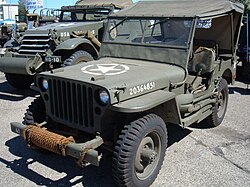Mid-engine design
A mid-engine layout describes the location of an automobile engine between the front and rear axles.[1] A physics term, moment of inertia, shows how hard it is to turn a moving object.[1] In a front engine front-wheel drive car, the drive wheels also have to steer the car, causing torque steer (pull to one side during Acceleration).[2] Front-wheel drive can cause the vehicle to oversteer (turn more sharply than the driver expects) in a corner. A front engine rear-wheel drive can have good weight distribution (balance front to rear), but has a higher moment of inertia than mid engine layout.[1] The mid-engine layout has none of these disadvantages. It has better weight distribution and a lower moment of inertia.[3] Its main disadvantage is that the engine, mounted in the middle, leaves much less room for passengers and cargo.[3] However, in racing there is usually only a driver so passengers and cargo are not an issue.
Mid-engine Design Media
The Lotus Europa S1 was based on a prototype built to compete for Henry Ford II's contract to build a Le Mans race car in the early 1960s.
Underfloor mid-engine in a historical Hanomag truck chassis.
References
- ↑ 1.0 1.1 1.2 "Developing a Track Car". DrivingFast.net. Archived from the original on 27 September 2016. Retrieved 11 June 2016.
- ↑ "Advantages and Disadvantages of Rear Wheel Drive". Mechanical Engineering. Retrieved 11 June 2016.
- ↑ 3.0 3.1 "Front vs Mid Engine". WhyHighEnd.com. Archived from the original on 14 August 2016. Retrieved 11 June 2016.








